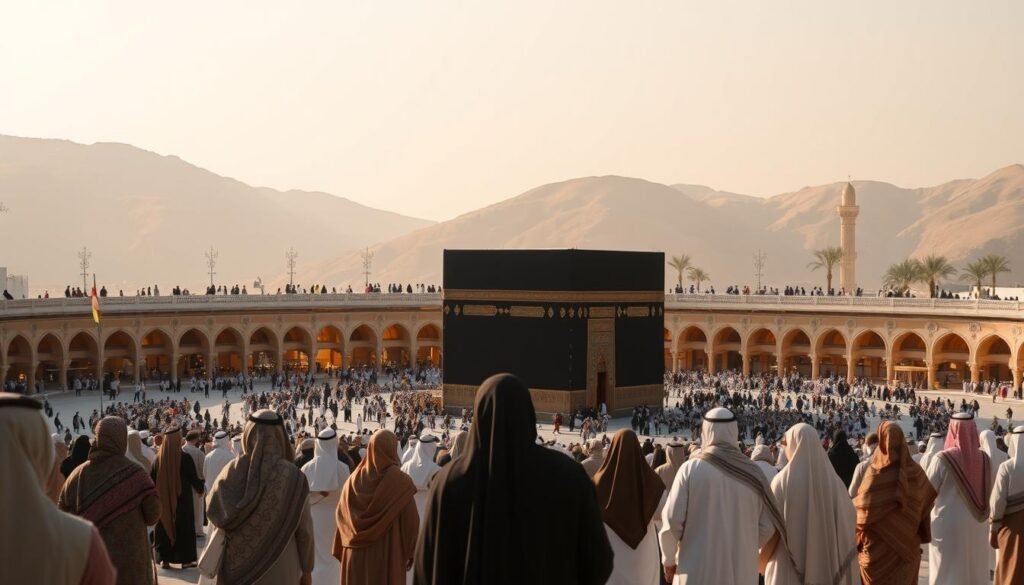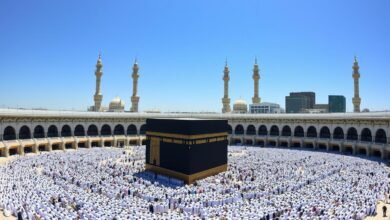Visiting Holy Sites in Saudi Arabia: Essential Etiquette

Traveling to Saudi Arabia’s holy sites is a journey filled with deep religious meaning and cultural richness. Before you start, it’s important to know the rules and customs of these sacred places. Showing respect for local traditions is key to fully enjoying your visit.
Ever thought about how to act right when visiting Saudi Arabia’s most sacred spots? What rules and practices make your visit meaningful and respectful to the locals? Let’s explore the must-know etiquette for visiting holy sites in Saudi Arabia. This will make your trip both enriching and enlightening.
Understanding Saudi Arabia’s Sacred Landscape
Saudi Arabia is a place of great reverence for Muslims, attracting millions each year. These sites are not just important; they are deeply meaningful. They offer a journey of the soul for both pilgrims and tourists.
Major Holy Sites in Saudi Arabia
Mecca and Medina, the two most sacred places in Islam, are in Saudi Arabia. Mecca is where the Prophet Muhammad was born and the Kaaba is located. The Kaaba is the focal point of Muslim prayer. Medina is where the Prophet Muhammad is buried and has the Masjid al-Nabawi, a huge mosque.
Historical Significance of Islamic Holy Places
These sites are key to Islam’s history. They are where major events shaped the religion. Pilgrims come to connect with their faith and grow spiritually.
Religious Tourism Overview
Religious tourism, especially the Hajj pilgrimage, is vital to Saudi Arabia’s economy. Millions of Muslims visit each year, boosting the economy and creating jobs. The government has worked hard to improve facilities for visitors, making their experience better.
| Holy Site | Significance | Annual Visitors |
|---|---|---|
| Mecca | Birthplace of Prophet Muhammad and site of the Kaaba | 2-3 million |
| Medina | Resting place of Prophet Muhammad and Masjid al-Nabawi | 1-2 million |
Etiquette and Expectations for Visiting Holy Sites in Saudi Arabia
Visiting holy sites in Saudi Arabia requires respect for the local culture and the sacred places. As a guest, you must follow certain rules. These rules show your respect for Islam and the local community.
Dressing modestly is key. Men and women should cover their shoulders, arms, and legs. Women must wear a headscarf or abaya in mosques and holy sites.
Remember to remove your shoes before entering a mosque. This is a sign of respect. Also, avoid loud noises, eating, or drinking in these areas. Interact with others quietly, as these places are for prayer and reflection.
| Etiquette Guideline | Explanation |
|---|---|
| Modest Dress Code | Cover shoulders, arms, and legs; women must wear headscarves or abayas |
| Shoe Removal | Remove shoes before entering a mosque as a sign of respect |
| Quiet Behavior | Avoid making loud noises, eating, or drinking inside sacred spaces |
| Respectful Interaction | Interact with other visitors quietly and reverently |
By following these guidelines, visitors show respect for Saudi Arabia’s holy sites. This makes their visit more meaningful and enriching.
Essential Dress Code Guidelines for Holy Places
Visiting sacred sites in Saudi Arabia requires following the dress code. This shows respect for the religious and cultural traditions. The dress code helps keep these places revered and sacred.
Appropriate Attire for Men
Men should dress modestly at holy sites. They need to cover their shoulders and knees. Long pants and shirts with sleeves are best. Shorts, tank tops, and revealing clothes are not allowed.
Dress Requirements for Women
Women’s dress code is stricter. They must wear loose, opaque clothing that covers their entire body, including their head. An abaya, a long robe, is traditional. They also need a headscarf, or hijab, to cover their hair.
Footwear Regulations
- Visitors must remove their shoes before entering holy sites.
- Socks or stockings are needed, as bare feet are not allowed.
- Wear comfortable, closed-toe shoes for easy removal and protection.
Following the dress code for mosques and other religious sites in Saudi Arabia shows respect. It enhances your experience and shows reverence for the local culture and beliefs.
Preparing for Your Holy Site Visit
Visiting the sacred sites in Saudi Arabia is a deep and meaningful journey. It’s key to prepare well to show respect and make the most of it. You’ll need to know the specific rules for each site you plan to see.
First, look into the dress code and any other rules for the sites. This helps you pack right and stay comfortable. Also, get ready for the spiritual vibe of these places. Approach them with respect and an open heart.
Key Preparation Tips:
- Research the dress code and other site-specific requirements
- Pack modest, conservative clothing that covers your arms and legs
- Bring any necessary items like a headscarf or prayer rug
- Familiarize yourself with the history and significance of the holy sites
- Approach the sites with a respectful and open mindset
By preparing well, you’ll dive deep into the sacred atmosphere. You’ll have a truly meaningful visit to the holy sites of Saudi Arabia.

Behavioral Guidelines Inside Sacred Spaces
Visiting holy sites in Saudi Arabia requires being mindful of certain behaviors. It’s important to respect cultural norms to have a meaningful experience. This includes following prayer time protocols and interacting with others appropriately.
Prayer Time Protocols
During prayer times, it’s crucial to be silent and avoid disruptions. Don’t walk through prayer areas. Instead, sit or stand aside to let worshippers focus.
Keep the atmosphere reverent and contemplative. This honors the sacred moment.
Interaction with Other Visitors
When talking to others in holy sites, remember to be quiet and respectful. Avoid gestures or actions that might seem intrusive. Approach others with respect and openness, recognizing the shared reverence for the space.
Voice and Movement Etiquette
Keep your voice low to maintain peace in the holy sites. Avoid loud talking or laughter that could disturb the calm. Move with purpose and mindfulness, avoiding boisterous actions that might disrupt the atmosphere.
Following these guidelines shows respect for cultural norms. It ensures a meaningful and respectful visit to holy sites in Saudi Arabia.
Photography and Electronic Device Policies
Visiting holy sites in Saudi Arabia means following certain rules about photography and electronic devices. These rules help keep these places sacred and respectful for everyone.
Most Islamic holy places allow photography, but with some rules. You can’t take pictures in prayer areas or during ceremonies. But, you might be able to take photos in other parts without disturbing others.
- Photography is typically prohibited in prayer halls, during prayer times, and near worshippers engaged in devotional practices.
- Visitors may be required to obtain permission or a permit before taking photographs, especially in more sensitive areas.
- The use of tripods, flashes, and other equipment that may disrupt the spiritual ambiance may also be restricted.
Using electronic devices like smartphones and tablets also has rules. You can use them to find your way or look up information. But, avoid making calls or sending messages that might distract from the place’s sacredness.
It’s key to respect each holy site’s specific rules in Saudi Arabia. By doing so, you’ll have a deep and meaningful visit. You’ll also show respect for the site’s religious and cultural importance.
Prohibited Items and Activities at Holy Sites
When you visit Saudi Arabia’s sacred sites, it’s important to follow local customs and rules. Knowing what you can’t bring or do helps you have a respectful visit. This knowledge lets you plan better and enjoy your spiritual journey.
Restricted Objects List
Some things are not allowed at Saudi Arabia’s holy sites. This includes weapons, alcohol, pork, and drugs. Also, you can’t bring religious texts or symbols that don’t follow Islamic teachings. Make sure to leave these items at home or store them before you enter.
Security Checkpoint Procedures
When you get to holy sites, you’ll go through security checks. These checks use metal detectors and bag inspections. It’s important to follow what the security team asks and let them check your stuff. Don’t bring banned items, as they’ll be taken and you might get extra checks or not be allowed in.
Storage Options for Personal Items
- Many holy sites have safe places to store items you can’t bring inside.
- These spots are near the entrance or security checks, so you can pick up your things when you leave.
- Using these services helps you visit without worrying about carrying things you shouldn’t.
Knowing what you can’t bring or do at Saudi Arabia’s holy sites helps you plan better. It ensures your visit is meaningful and respectful. It’s key to keep these places sacred by following the rules.
| Prohibited Items | Allowed Items |
|---|---|
| Weapons, alcohol, pork products, drugs | Personal belongings (with restrictions), religious texts/symbols aligned with Islamic teachings |
Special Considerations for Hajj and Umrah Visitors
For those going on Hajj or Umrah in Saudi Arabia, there’s more to know. These journeys are sacred and require deep respect and following Islamic traditions. This makes the experience both meaningful and life-changing.
Hajj is an annual pilgrimage to Mecca, and Umrah is a voluntary one that can be done anytime. Both are very important in the Muslim faith. People going on these trips need to learn about the special rituals, what to wear, and how to behave at these holy places.
Preparing for Hajj and Umrah
Before you go, here’s what to do:
- Get your Hajj or Umrah visa and fill out all needed papers.
- Book your stay and travel in Saudi Arabia.
- Learn the steps and times for the pilgrimages.
- Make sure you have the right clothes, like Ihram garments for Hajj.
- Know what you can’t bring or do during the trip.
Rituals and Etiquette for Hajj and Umrah
Here’s what to do during the pilgrimage:
- Do the Ihram ritual, wearing white clothes and avoiding certain actions.
- Pray and say special prayers at places like the Kaaba, Mecca, and Medina.
- Avoid any actions or behaviors that are not respectful in these sacred areas.
- Show respect and humility, as these trips are very spiritual for Muslims.
Learning about the special rules and expectations for hajj and umrah trips helps visitors have a deep and impactful experience at the islamic holy sites in Saudi Arabia.
Cultural Sensitivity and Respect Tips
Visiting holy sites in Saudi Arabia requires respect for local culture and traditions. It’s not just about following basic rules. There are more steps to take to show true reverence.
Understanding and following the dress code is key. While there are specific rules, try to fit in with the locals. Avoid clothes that might seem too flashy or disrespectful. This shows you value the site’s holiness.
- Observe the local customs and traditions, even if they differ from your own cultural norms.
- Refrain from behaviors that may be considered disruptive or disrespectful, such as loud conversations or inappropriate gestures.
- Be mindful of your body language and avoid any actions that could be interpreted as confrontational or disrespectful.
- Engage with the local community with a humble and appreciative attitude, seeking to learn about their beliefs and practices.
Showing deep respect for Saudi Arabia’s cultural norms can make your visit better. It also helps protect these sacred places. By adapting and honoring local customs, you’ll win the community’s appreciation. This can lead to a positive and meaningful exchange.
| Behavior | Recommended Action |
|---|---|
| Loud conversations | Speak softly and respectfully |
| Inappropriate gestures | Avoid any actions that could be seen as disrespectful |
| Disruptive movements | Move quietly and mindfully within the sacred spaces |

Conclusion
Reflecting on our journey to explore Islamic holy sites in Saudi Arabia, I’m amazed by the deep respect and cultural awareness needed. We’ve covered the importance of etiquette, dress codes, and behavior. These are key to honoring these sacred places.
Learning about the history of these sites and how to act during prayer times has deepened my respect. We’ve also discussed rules on taking photos, what items are banned, and security measures. These details show how crucial it is to be thoughtful and aware of the local traditions.
Visitors to islamic holy sites in Saudi Arabia can make a positive impact by showing respect, modesty, and reverence. This not only enriches their own experience but also helps protect these sacred places for future generations.
FAQ
What is the proper etiquette for visiting holy sites in Saudi Arabia?
Visiting holy sites in Saudi Arabia means showing respect for Islamic traditions and local culture. You should dress modestly and avoid loud or disruptive behavior. Also, be aware of prayer times and areas that are off-limits.
Can I take photographs inside the holy sites?
Photography is usually allowed in some holy sites, but there are rules. Always be respectful and don’t take pictures of people or sensitive areas without permission.
What is the dress code for visiting mosques and other holy places in Saudi Arabia?
Both men and women should wear modest, loose clothing that covers the body. Women must also cover their hair and avoid showing their arms or legs. Remember to wear proper footwear, like socks or shoes that can be easily removed.
Are there any prohibited items or activities at holy sites in Saudi Arabia?
Certain items, like alcohol, drugs, and weapons, are not allowed at holy sites. You might need to go through security checks and leave any banned items behind before entering.
How should I behave inside the holy sites?
Inside holy sites, it’s important to be respectful and quiet. Avoid loud behavior and be aware of prayer times. It’s also best to speak softly, not eat or drink, and not touch others.
Are there any special considerations for those performing Hajj or Umrah pilgrimages?
Pilgrims on Hajj or Umrah must follow special rules and rituals. This includes wearing the Ihram garment and performing specific prayers and rituals. They must also follow strict rules during the pilgrimage.
How can I be culturally sensitive when visiting holy sites in Saudi Arabia?
Being culturally sensitive means more than just following basic rules. It’s about showing deep respect for Islamic culture and traditions. Be mindful of local customs, avoid behavior that might offend, and approach the sacred spaces with reverence and humility.




